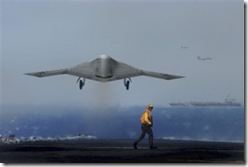UCAVs gain ground in the USN
 Bill Sweetman reports that UCAVs as a concept, and NG’s X-47B in particular, are getting increasingly popular with the USN’s aviation community:
Bill Sweetman reports that UCAVs as a concept, and NG’s X-47B in particular, are getting increasingly popular with the USN’s aviation community:
The Navy is looking at longer ranges, driven by the threat from anti-ship ballistic missiles and other weapons. "Navy aviation is run by a whole generation of Hornet people and their vista is 450 nm, and they assume that the Tomahawks will take care of the IADS [integrated air defense system]. But if the Tomahawk ships can’t get in there…"
Beard showed some new Northrop Grumman comparisons that pit the UCAV against a notional future Navy fighter (resembling a super-F-35 with a greater range). The big difference at long range is that the manned fighter can only run into the target once after hitting the tanker, because of human endurance limits. The UCAV is good for 50 hours endurance and can make four-to-six trips into the target before flying back to the carrier.
Nice to see that Kurt Plummer’s long-standing arguments in favor of UACVs are finally being recognized :)
Comments
7 Responses to “UCAVs gain ground in the USN”
Leave a Reply
You must be logged in to post a comment.






Interesting but wonder where the UCAV drivers would go? Local on the carrier or somewhere in the continental US. If on carrier what would this do to the silence of the group? If in the US could whole squadrons become useless if a sophisticated enemy is able to attack space or land relay sites?
Seems like tons of things to think through beyond just basing them on the CV.
BTW wonder what UCAV’s do to ready times?
Good point about pilot basing. My guess would be the pilots stay in the carrier and use satellite links as much as possible, to reduce the chances of SIGINT intercepts.
Ready-times… the reduced maintenance combined with the lack of human rest/endurance restraints would probably slash them dramatically. May be even talking about 10-20 mins tops.
Re: Pilots and datalinks – it’s my humble uneducated guess that there will be guidance uplink via airborne relays, not satellites, but the images/sensor data will be fed from the UCAV to the sat and then down to the carrier. Basing pilots in the US doesn’t really make sense for co-ordination with manned aircraft.
Yeah it will be interesting to see how these kind of problems our solved. The other services seem to have much more experience at this kind of thing due to operations over Iraq and Afghanistan.
We’re all forgetting the end state – autonomous UCAVs – Skynet-brainwashed, of course. Reminds me of going to see the movie… Autonomous AI is quite actively pursued, to be serious.
For the UAVs,Navalised version of the Global Hawk,RQ-4N BAMS are known to be in trials to gain IOC by 2019.If true,than the USN would be operating their first major UAV(UCAV) after the unfortunate DASH Program.
2019? Why that late?